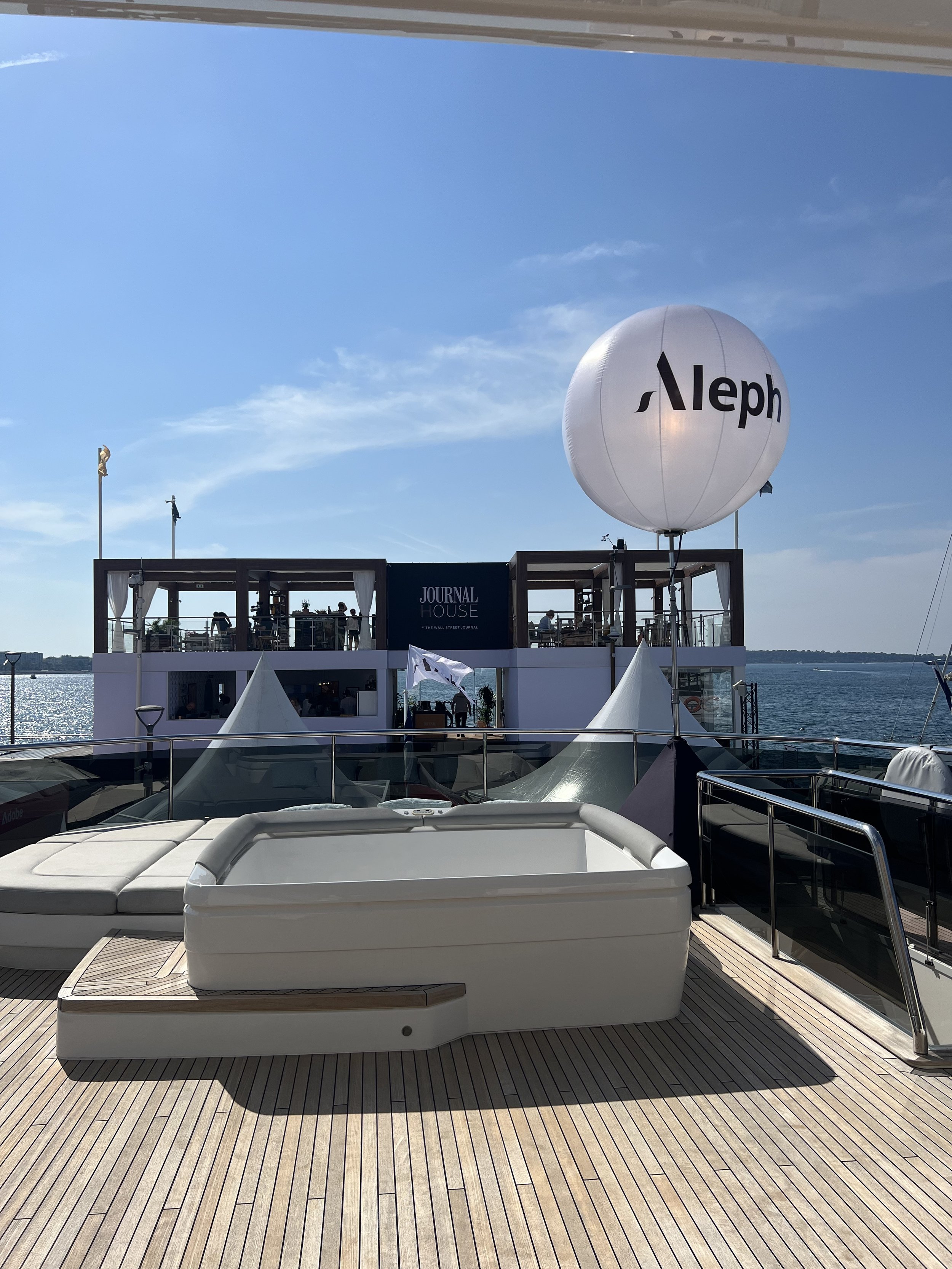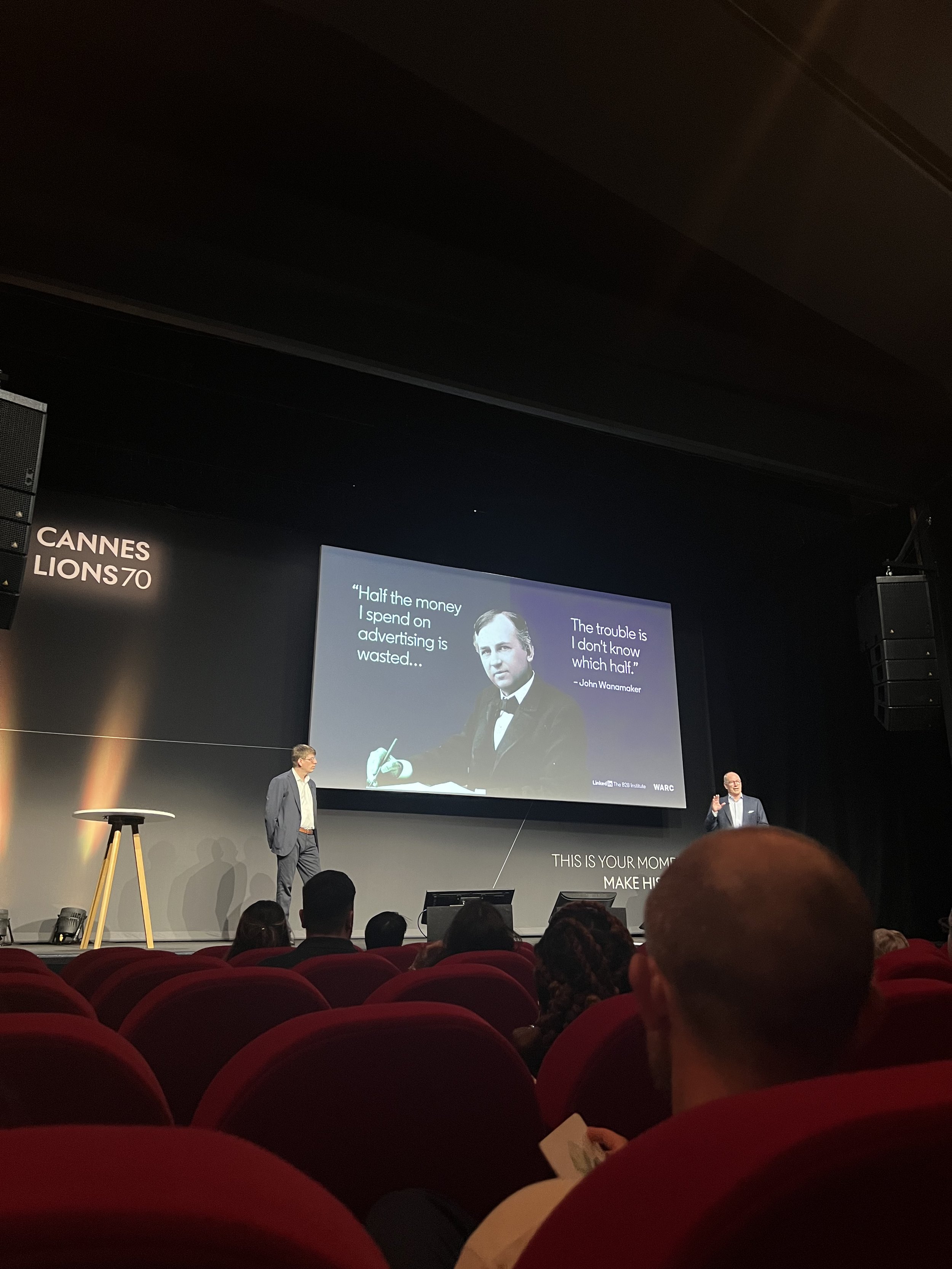Day 6 - Monday, June 19th
This was the first day of the festival. I didn’t know what to expect but was excited to experience everything there was to offer. It took me a day to learn the ropes of how to Cannes.
10:00 Aleph Yacht - Panel with Snapchat
My first talk of the day was actually an opportunity presented by one of my classmates. A bunch of us got the pleasure of going on the Aleph Yacht with Snapchat. Aleph was doing a panel with different employees from Snapchat and Aleph. Elyse Estrada, the Global CMO at Aleph, was the moderator and interviewed:
Rob Wilk - President, Americas @ Snap
Dave Roter - VP Global Agency & Brand Partnerships @ Snap
Alex Dao - Global Director, Business Expansion & Sales Partnerships @ Snap
Pooja Piyaratna - VP Product Marketing @ Snap
Amaia Navas - Sales VP, Western Europe @ Aleph
An Aleph device is “ a digital content series providing real-life, honest, and vulnerable advice from leading digital experts within the Aleph network.” The first person to speak was Rob Wilk. Estrada and Wilk started by talking about the three things to nail at an interview:
Know the product(s) of the brand. Know what you don’t like about the product and have ideas to improve the product. Also, need to have a passion for the brand.
Research the company and the people in the company.
Be able to answer, “Why should we hire you?”
Wilk then talked about how sales are all about relationships. It is important to put yourself out there and make those relationships. It should not be about a win or loss when you have to have an intense conversation (i.e., if a plan didn't go right). Wilk advised us students saying, at our age, it doesn't matter if we have no experience because we are building it. We should care about the product and know it well. He said you should think about who you want to hitch your wagon to when talking about mentors. Speaking very candidly about his mentor, Todd Anderman, he stated that Anderman was disarming and unbelievably kind. Wilks's top tips for people in advertising who want to use Snapchat is to start with a small campaign and find something that works and double down. His mantra is "ego will be the death of your career."
After Wilk was David Roter, he answered the same general questions. His top tips for interviews were:
Do your research/homework.
Look for people who aren't assholes. Look for people who are real and kind.
Look for diversity/inclusion (perspectives and background). Once a whole team is together, it's about how to create an inclusive environment.
David Roter's advice was to ask for help. You have the right, and people love to help. Not enough people ask for it. His mantra is to be kind to your mind and to yourself. His reasoning was to be kind to others starts with yourself.
At this point, there had been many technical difficulties with filming. While I did not get to see everyone talk, in order to not miss out on other events, I was extremely grateful for this experience. Many other companies were also doing talks that they were taping. However, they are all private. We were the only students there with all the speakers, which made it more intimate and personal.
12:45 Cannes Lions | Future Gazers: The Human Cost of Predictive AI, The Cultural Climate of New Luxury, Social Influence
I ended up going to this talk because I was late to a different talk, and someone I was with suggested this one instead. Dina Elrayyes, VP of Content & Creative Director at Ascential, was the moderator with Aurielia Noel, Global Head of Innovation and Digital Transformation at Dentsu X, David Fischer, Founder and CEO at Highsnobiety, and Mobbie Nazir, Chief Global Strategy Officer at We Are Social. They started the conversation by discussing the codes of luxury (access, knowledge, and collaboration) and how they have changed. To be a cultural pioneer, you must be a trendsetter, knowledgable, culturally credible, and meaningful. The pillars of a cultural pioneer are world being, curation, and inspiration.
World being - consumers want to live in a world you created for them
Curation - figure out the right brand product for core messaging
Inspire - attention is a big currency
They are seeing a change to the culture of influence. There are 3 big shifts: participation, how people are working in their spaces, and patronage. When discussing the Metaverse, they discussed how what we knew about it last year was already obsolete. We need to be brave and bold. When teaching people about AI, they try to show them it is safe and helpful. We control the tools. They don’t control us. They realize they need to be transparent and authentic to consumers about it. For me, this talk was and wasn’t pertinent. I was not as interested in this topic. However, it is relevant because AI is already here and will only improve over time. I was interested to hear their thoughts on virtual influencers because I did not understand why people would follow someone who isn’t a real human. They discussed the difference between having a virtual vs. real-life influencer promote a brand or product. Teaming up with creators and people who can navigate the space is great for brands. Content is a driving factor for virtual influencers.
Audience Questions:
How do you connect to the younger generation?
Tracey Panek explained that Levi’s collaborated with the brand Jordan. This connected Levi’s to the younger generation through fashion. They partnered with Rolling Loud. This connected younger people through music. Through relevant and authentic temples, they always had new stories to tell.
Did you have to innovate and make changes to 501 jeans?
The 501 Jeans have not been changed. The jeans are timeless and classic. Levi’s doesn’t chase trends.
As someone who has bought Levi’s 501 Jeans many times before, I loved seeing the stories behind the jeans. The stories they share are really a testament to the product.
Here’s a link to an article that shares some of Levi’s stories: https://www.levi.com/US/en_US/features/greatest-story-ever-worn
Sofia Hernandez, Global Head of Business Marketing at TikTok, and Michelle Crossan-Matos, Chief Marketing Officer at Ulta Beauty, talked about how TikTok has helped brands advertise and reach their target audiences on a larger scale. Hernandez started by stating, "TikTok is entertainment. It is not social media." Millions dive into consuming a movie's worth of content. Community is about co-creation. It inspired us. TikTok is filled with so many likes and interests. Brands have a place on TikTok. It invites brands in, but only if they do it the way the community exists. Brands need to show up authentically. Brands want trusting relationships with their audience and advocates. An example Hernandez gave was Taco Bell. The company had discontinued an item, and when Doja Cat found out, she went online and posted a TikTok that they should bring the item back. This re-engaged the Taco Bell community. Another way a brand used TikTok for advertising was Ryan Air saw a trend and made a video participating. Porsche noticed that communities engaged in comments, so the brand got someone to make comments into a song. This produced 11 million views with around 500,000 likes and 3,000 comments. That level of engagement doesn't exist anywhere else. Hernandez says brands need to think like a marketer but act like a creator. Michelle Crossan-Matos went on to talk about how TikTok has boosted Ulta's reach. I'm personally on TikTok way too much. I typically try to skip any apparent ads. However, I think the types of content creation that were shared are branded content that I would continue watching.
13:30 The B2B Institute at LinkedIn and Roger L. Martin Inc. | How A Promise To The Customer Gives Campaigns The Edge
The speakers for this talk were Jann Schwarz, Global Head of the B2B Institute at LinkedIn, and Roger L. Martin, Founder and President at Roger L. Martin Inc.. They talked about the importance of creating a brand promise in a campaign and finding a model that does both demand capture and demand creation. Creating a social buzz feels great but isn’t great long term. They stated that we need to ask questions like, did this campaign gain market share? What are the long-term benefits? They used GEICO as an example of a promise which is where the gecko says they can save you 15% if you give them 15 minutes. The promise is a unified message that is memorable, valuable, and deliverable across multiple campaigns. Their use of examples made a point of connecting customers to the promise as a key tool in developing a successful campaign. This was my favorite talk of the day. It was more of a presentation than a conversation, unlike most of the talks I went to. I think this topic was very useful, and I liked the examples.
14:00 Droga5 part of Accenture Song and Levi’s | The Product, the Hero
Scott Bell, Chief Creative Officer at Droga5, Kenny Mitchell, SVP and Chief Marketing Officer at Levi's, and Tracey Panek, Historian, Director, Levi Strauss & Co. Archives at Levi's, sat down to talk about Levi's hero, its 501 Jean. From a pure product standpoint, it's the most user-tested ever worn. Authenticity is what has made them embraced by the world. They tell stories with unforgettable settings and a ton of antagonists and underdogs, but the story has no end. There are always new characters and chapters. A strong brand tells a story. This creates enormous value for brands. The importance of emotionally driven storytelling is to get deeper connections with consumers that drives trust and loyalty. Levi's is raising the floor by investing in brand storytelling. This helps make long-term brands. The 501 Jeans have always been the hero in human storytelling. They have product integrity, so they have storytelling integrity. Fans have been telling their own stories, so they don't need fictional ones. Levi's wants an anthology of stories. It is an ever-expanding story - the greatest story ever worn. One of the stories that surprised me was that someone traded jeans for a cow. It was a man who lived in a farmer's village from the Soviet Union. Levi's featured his story, which caused the family to feel recognized.
4 main points to remember: The 501 Jeans are at the heart, but human stories are at the core.
Stay true to core product values - 501 represents individuality and authenticity
Embrace the community that adopts your products - constantly redefined by people who wear them
Use products to tell culture-forward stories - connect with prevailing cultural themes
Take risks with the product front and center, even if felt controversial or unconventional
15:50 TikTok | How Community and Entertainment are Transforming Purchasing Habits Globally
Creative Marketer of the Year Showcase
Before meeting with the group, I had some free time to line up for the award show, so I checked out the Marketer of the Year Showcase. This year that award belonged to AB InBev. Showcased were 12 of the award-winning campaigns of its “creative solutions that helped the world’s leading brewer to transition from ‘Brand Buyer’ to a ‘Brand Builder’.” Since 2018, AB InBev has won 133 Lions with 21 Brands across 10 countries. It’s really cool to see the advertising brands behind some of these well-known companies. I typically don’t think about there being another party, and it is interesting to get a closer look into these campaigns. I also thought it was cool that AB InBev had a limited edition can of rose served at happy hour on the terrace.










